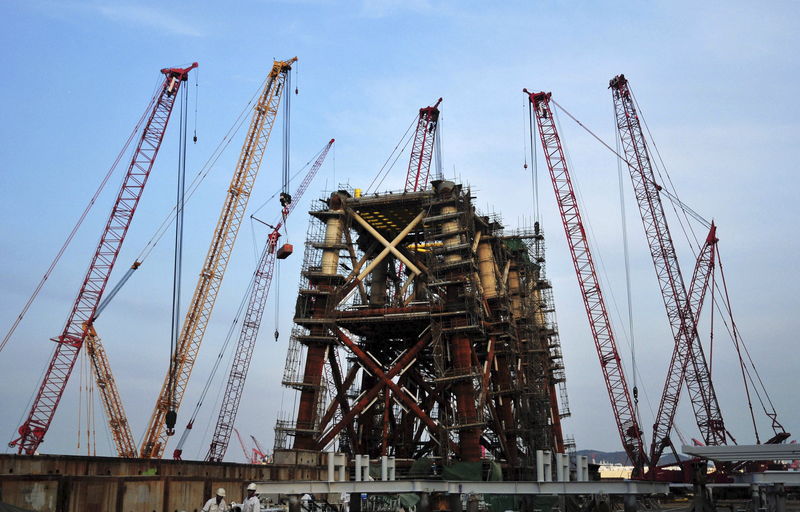By Isabel Woodford
MEXICO CITY (Reuters) – For Mexican industrial park owners like Sergio Bermudez, business is booming amid a wave of U.S businesses setting up over the border.
So-called nearshoring has pulled over $9 billion into Mexico since last October by manufacturers like Unilever (NYSE:) , Barbie maker Mattel (NASDAQ:) , and Tesla (NASDAQ:) , lured by its proximity to the giant U.S market, cheap labor, and geopolitical stability.
Yet Bermudez and many of his 400-strong cohort have a serious cost issue on their hands: energy.
Industrial parks are under pressure to spend millions of dollars to build federal power transmission lines and substations amid government underinvestment, growing energy demand, and aging infrastructure which is at capacity.
While these parks have long contributed to state infrastructure, the lines and specifications now required are getting much longer and costlier in Mexico’s manufacturing north, according to nearly a dozen sources.
“Federal funds can’t keep up with the growth we’re seeing… so the developers or companies have to absorb the cost,” said Eduardo Martinez, an official for the state of Nuevo Leon, pointing to austerity and the unpredicted nearshoring boom.
Sergio Arguelles, president of the Mexican Association of Private Industrial Parks (AMPIP), said parks’ investment in state energy assets today is unprecedented. The group is yet to calculate exact amounts, but said it is “very significant.”
The lure of new clients for parks is strong, but it is still a bitter pill: with regulation restricting private ownership, park owners essentially donate the infrastructure to the state.
“It’s the biggest challenge…We are thinking about how are we going to reach an agreement with the government to manage this for the good of the country,” said Aaron Gallo, the real estate director at American Industries, whose multiple Mexican industrial parks cater to foreign clients like Danish toymaker Lego.
American Industries is currently building a $12 million 12-kilometer (7.5-mile) line. Gallo said such investments mean they have as much as tripled energy costs for clients in recent years, complicated by lengthy permit processes.
“It’s very bureaucratic, it does slow us down,” said Gallo. “But there’s no other option.”
The issue underscores the holes in President Andres Manuel Lopez Obrador’s attempt to concentrate power in the state energy utility company, CFE, which critics say is unfit to support Mexico’s major growth opportunity.
Though private sector assistance may help bolster Mexico’s energy security in the short term, much more is needed accommodate the wave of new demand, said David Gantz, a fellow on U.S -Mexico trade at the Baker Institute.
“Mexico would be very well positioned to take advantage of nearshoring if it didn’t have such an energy problem,” he said.
CFE did not respond to a request for comment.
THE SHRINKING STATE
Mexico’s approach to its groaning electricity grid is in contrast to its fast-growing peers, which tend to either incentivize private energy contractors or have state utility companies with deep pockets.
Last year, CFE investment slid to 35.3 billion pesos ($2 billion), or 0.15% of GDP, a fraction of manufacturing rival China’s planned investment in the grid of 0.9% of GDP, per Reuters analysis.
Meanwhile, CFE built just under 150 km of transmission lines last year, more than 10 times less per 100,000 square km than in Brazil, where Electrobras said it added 8,679 km to the network.
“We needed a lot more,” said AMPIP’s Arguelles, noting the bulk of CFE’s budget has gone to power generation rather than distribution and transmission infrastructure.
Lopez Obrador has pressed hard to tighten state control of the energy sector, arguing that past governments rigged the market in the favor of private companies.
Yet with billions dedicated to the heavily indebted state-oil company Pemex, industry observers say Mexico lacks the funds to support upgrades to the electricity network.
“The CFE had a very different vision and budget before,” said Bermudez, whose family has been in the “maquiladora” or remote manufacturing business for decades. “It used to be much easier.”
Indeed, 91% of parks report issues related to energy supply, according to a recent AMPIP survey, including line congestion and being forced to turn away new clients.
Meanwhile, Ramses Pech, CEO of energy consultancy firm Group Caraiva estimated 80% of infrastructure built in industrial areas is now privately funded.
Still, there is some hope for the new wave of 47 planned industrial parks. The energy ministry said it plans to build around 3,000 km of transmission lines next year, as well as new substations, particularly in the north.
FOOTING THE BILL
Some argue that it is only right that the private sector pay its own way, especially given Mexico’s relatively low corporation tax, and parks’ healthy return on investment.
Hans Joachim Kohlsdorf, an electricity wholesale executive in Mexico, argues that park owners often do not think strategically when setting up remote manufacturing hubs, and understands why the government is reticent to pay.
“There needs to be better planning,” he said. “We’re in a Catch 22: (the parks) want everything free, and the other party doesn’t want to pay.”
Zonia Torres, a commercial director of an industrial park in the state of Guanajuato, which has paid for federal infrastructure, agrees.
“The CFE doesn’t want to bet on future (energy) demand,” she said, adding that Mexico is still “an emerging market” with limited resources.
Yet critics say Mexico’s push for state control over energy distribution while also neglecting it is self-sabotage.
“The network provider should be capable of building the infrastructure…The public policy does not take into account the reality, and the level of (foreign) demand.” said Alfredo Nolasco, founding partner of nearshoring consultancy Spyral.
“The lack of foresight is likely to be disastrous.”
Read the full article here













